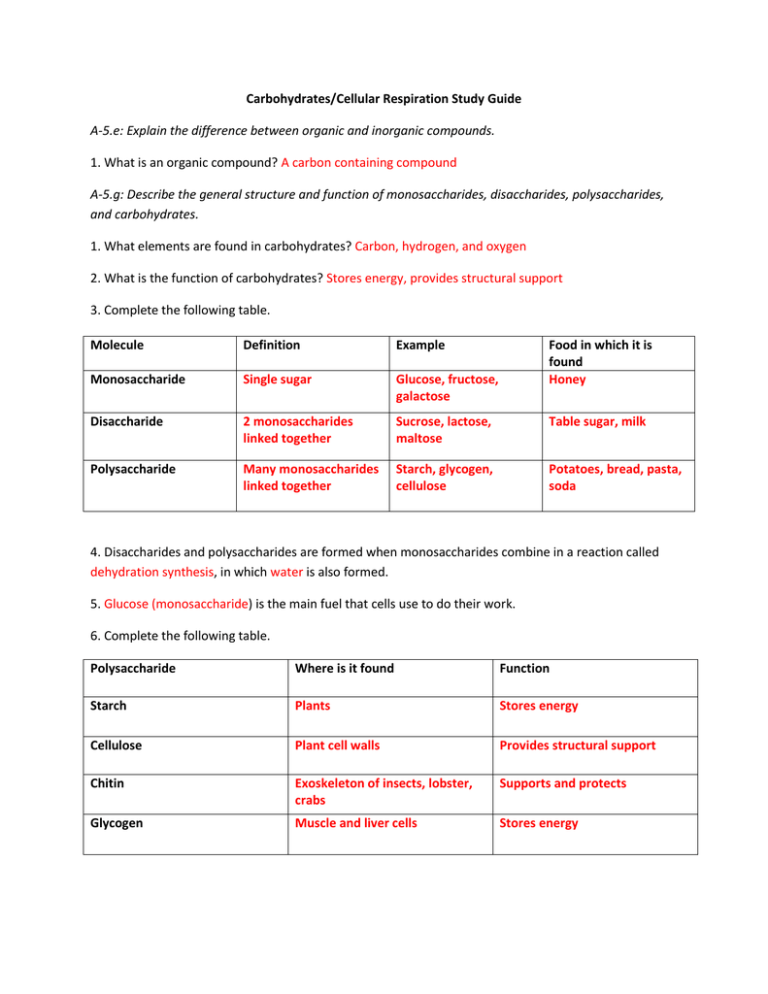Carbohydrates/Cellular Respiration Study Guide Answers
advertisement

Carbohydrates/Cellular Respiration Study Guide A-5.e: Explain the difference between organic and inorganic compounds. 1. What is an organic compound? A carbon containing compound A-5.g: Describe the general structure and function of monosaccharides, disaccharides, polysaccharides, and carbohydrates. 1. What elements are found in carbohydrates? Carbon, hydrogen, and oxygen 2. What is the function of carbohydrates? Stores energy, provides structural support 3. Complete the following table. Molecule Definition Example Food in which it is found Honey Monosaccharide Single sugar Glucose, fructose, galactose Disaccharide 2 monosaccharides linked together Sucrose, lactose, maltose Table sugar, milk Polysaccharide Many monosaccharides linked together Starch, glycogen, cellulose Potatoes, bread, pasta, soda 4. Disaccharides and polysaccharides are formed when monosaccharides combine in a reaction called dehydration synthesis, in which water is also formed. 5. Glucose (monosaccharide) is the main fuel that cells use to do their work. 6. Complete the following table. Polysaccharide Where is it found Function Starch Plants Stores energy Cellulose Plant cell walls Provides structural support Chitin Exoskeleton of insects, lobster, crabs Supports and protects Glycogen Muscle and liver cells Stores energy 7. What disease is caused by the inability to remove glucose from the blood? diabetes 8. List 3 side effects of diabetes. Kidney disease, eye problems, inability to heal wounds, nerve damage, poor circulation 9. What hormone is responsible for removing glucose from the blood? insulin A-5.d: Show how chemical reactions can be represented by chemical formulas. 1. Write the chemical formula for cellular respiration. C6H12O6 + O2 H2O + CO2 + energy 2. Write the chemical formula for photosynthesis. H2O + CO2 + sunlight C6H12O6 + O2 3. Compare and contrast the chemical formulas for cellular respiration and photosynthesis. Photosynthesis and cellular respiration contain the same molecules (glucose, water, oxygen, and carbon dioxide). The reactants of photosynthesis are the products of cellular respiration. The reactants of cellular respiration are the products of photosynthesis. A-5.j Explain how cells store energy temporarily in ATP. 1. Cells store energy in ATP. Draw a molecule of ATP and label it. Energy 2. In the diagram of ATP, label where the energy is temporarily stored in ATP. Between the 2nd and 3rd phosphate group 3. When cells need energy they get it from ATP by removing a phosphate group. What new molecule is formed? ADP B-1.h Identify the cellular sites of and follow through the major pathways of anaerobic and aerobic respiration, compare reactants and products for each process, and account for how aerobic respiration produces more ATP per monosaccharide. 1. What is cellular respiration? The process of breaking down glucose for energy in the presence of oxygen. 2. What are the 3 major phases of cellular respiration? Glycolysis, Krebs Cycle, electron transport chain 3. Define the following: A. anaerobic: no oxygen B. aerobic: oxygen 4. What process do cells undergo in anaerobic conditions? fermentation 5. Complete the following table. Phase of CR Location Used Produced Glycolysis Cytoplasm Glucose, 2 ATP Krebs Cycle Mitochondria 2 Pyruvic acid Electron Transport Mitochondria (inner membrane) NADH or FADH2, O2 2 ATP, 2 NADH, 2 pyruvic acid 2 ATP, 2 FADH2, 8 NADH, 6 CO2 32 ATP, H20 6. What is NAD+? An electron acceptor 7. What does NAD+ become when it accepts electrons? NADH 8. Where does the electron transport chain get the high energy electrons that move down the chain? NADH and FADH2 9. What is the energy from the electrons in the ETC used for? to move hydrogen ions from the matrix to the intermembrane space, creating a concentration gradient (so that ATP can be formed) 10. On the back of this paper draw glycolysis, the Krebs cycle, and the electron transport chain. Show how products from one phase move on to the next. (turn your paper so it is in “landscape” orientation) Use your notes to complete this! 11. How many total ATPs are produced during cellular respiration? 36 (38 minus the 2 used in glycolysis) 12. How do NADH and FADH2 contribute to the production of ATP? They provide high energy electrons to the ETC 13. How does oxygen contribute to the production of ATP? It is an electron acceptor. It removes the low energy electrons from the ETC. 14. Why do cells need to undergo fermentation to make energy if glycolysis does not require oxygen? (What does glycolysis run out of?) glycolysis runs out of NAD+, fermentation converts NADH back to NAD+ 15. How many ATPs can be made in one round of fermentation? 2 (glycolysis makes 2, and fermentation replenishes NAD+ for glycolysis to continue) 16. Why can so many more ATPs be produced in aerobic conditions? Because oxygen accepts the electrons in the electron transport chain, allowing more electrons to move down the ETC, which creates more ATP 17. Complete the following table. Type of fermentation Where does it take place Chemical equation Alcoholic fermentation Yeast cells Pyruvic acid + NADH alcohol + CO2 + NAD+ Lactic Acid Fermentation Muscle cells, some prokaryotic cells Pyruvic acid + NADH lactic acid + NAD+ B-1.i Explain how photosynthetic organisms use the processes of photosynthesis and respiration. 1. Explain the carbon-oxygen cycle between plants and animals. Plants produce oxygen, which is taken in by animals for cellular respiration (plants also undergo cellular respiration). Animals release carbon dioxide, which is taken in by plants for photosynthesis. 2. Illustrate this cycle. 3. Explain the interdependence of plants and animals on each other. Plants rely on animals to produce carbon dioxide. Animals rely on plants to produce oxygen. 4. What gas do animals give off in the day? Carbon dioxide At night? Carbon dioxide 5. What gas do plants give off in the day? oxygen At night? Carbon dioxide 6. Do plants undergo cellular respiration? yes



